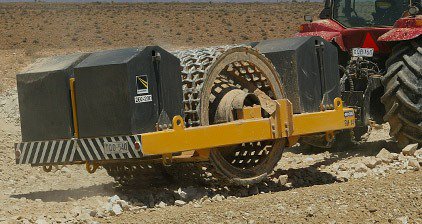Types of roller
Contents |
[edit] Introduction
Rollers are a type of construction plant used for compacting materials such as soil, gravel, sand, road surfaces and so on. The material can be compacted by vibration, impact loading, kneading, and direct pressure. Different types of roller can be used depending on the requirements of the project and the type of material that needs to be compacted.
[edit] Cylindrical roller
This is a traditional type of roller that is relatively lightweight and can be handled manually or, as was common throughout history, by animals such as oxen or horses. It is usually made of iron, concrete or stone and generally measures around 1 m in diameter and 1.5 m in length. The ground pressure that can be generated by a cylindrical roller is typically around 7 kg/cm2.
[edit] Sheepsfoot roller
Sheepsfoot rollers consist of a steel drum on which round or rectangular protrusions known as ‘lugs’ or ‘feet’ are fixed. There are different types of lug, such as spindle-shaped with widened base, prismatic and clubfoot. Rollers can also be static or vibratory.
The drum’s weight can be increased by ballasting with water, damp sand, or by mounting steel sections.
They are commonly used for compacting fine-grained soils such as heavy and silty clays. They are often used for compacting soils in dams, embankments and subgrade layers in pavements, road and railway projects.
The amount of soil compaction is governed by:
- The weight of the roller.
- The area of each lug.
- The number of lugs in contact with the ground.
- Total number of lugs per drum.
In general, 10 to 20 passes are required to provide complete coverage of the soil, and usually, the top layer of the consolidated soil will need to be finished with a smooth wheel roller.
[edit] Pneumatic tyred roller
Also known as rubber tyred rollers, these consist of a heavily-loaded wagon with several rows of closely-spaced tyres. They provide uniform pressure throughout the width covered, and are often used in pavement subgrade works, as they are suitable for compacting uniform coarse soils and rocks. They are also used to finish embankments compacted by sheepsfoot rollers
The factors which affect the amount of compaction that can be achieved are the weight, tyre inflation pressure and the area of contact.
[edit] Smooth wheeled roller
This type of roller incorporates a large steel drum at the front and one or two wheels or drums at the rear. If there is one wheel at the rear they are known as tandem rollers, and three-wheeled rollers if there are two wheels at the rear.
The weight of a tandem roller ranges from 2-8 tonnes, whereas the weight of a three-wheeled roller ranges from 8-10 tonnes. The ground pressure exerted by tandem rollers is typically around 10-17 kg/cm2.
The performance of a smooth wheeled roller depends on the load per cm width transferred to the soil (which is derived from the gross weight of the drum), and the drum diameter. They are most suitable for consolidating stone, gravel, sand, hardcore and ballast, but are not suitable for embankments, soft subgrades or uniform sands.
[edit] Vibratory roller
This type of roller is fitted with one or two smooth surfaced steel drums measuring 0.9-1.5 m in diameter, and 1.2-1.8 m in width. The drums vibrate by the rotation of an eccentric shaft inside. They are commonly used for compacting granular base courses and sometimes for asphalt, and are useful for compacting to greater depths.
They have higher outputs and improved performance compared to other rollers, but also generally come at a higher cost.
[edit] Grid roller
Grid rollers have a cylindrical heavy steel surface comprising a network of steel bars which form a grid with square-shaped holes. It is common for the roller to be ballasted with concrete blocks. This type of roller is generally a towed unit, and provides high contact pressure but minimal kneading action.
They are typically used for the compaction of well-graded coarse soils and weathered rocks, often in subgrade and sub-base road projects. They are not suitable for clayey soils, silty clays or uniform soils.
[edit] Find out more
[edit] Related articles on Designing Buildings Wiki
Featured articles and news
CIOB and CORBON combine forces
To elevate professional standards in Nigeria’s construction industry.
Amendment to the GB Energy Bill welcomed by ECA
Move prevents nationally-owned energy company from investing in solar panels produced by modern slavery.
Gregor Harvie argues that AI is state-sanctioned theft of IP.
Heat pumps, vehicle chargers and heating appliances must be sold with smart functionality.
Experimental AI housing target help for councils
Experimental AI could help councils meet housing targets by digitising records.
New-style degrees set for reformed ARB accreditation
Following the ARB Tomorrow's Architects competency outcomes for Architects.
BSRIA Occupant Wellbeing survey BOW
Occupant satisfaction and wellbeing tool inc. physical environment, indoor facilities, functionality and accessibility.
Preserving, waterproofing and decorating buildings.
Many resources for visitors aswell as new features for members.
Using technology to empower communities
The Community data platform; capturing the DNA of a place and fostering participation, for better design.
Heat pump and wind turbine sound calculations for PDRs
MCS publish updated sound calculation standards for permitted development installations.
Homes England creates largest housing-led site in the North
Successful, 34 hectare land acquisition with the residential allocation now completed.
Scottish apprenticeship training proposals
General support although better accountability and transparency is sought.
The history of building regulations
A story of belated action in response to crisis.
Moisture, fire safety and emerging trends in living walls
How wet is your wall?
Current policy explained and newly published consultation by the UK and Welsh Governments.
British architecture 1919–39. Book review.
Conservation of listed prefabs in Moseley.
Energy industry calls for urgent reform.































